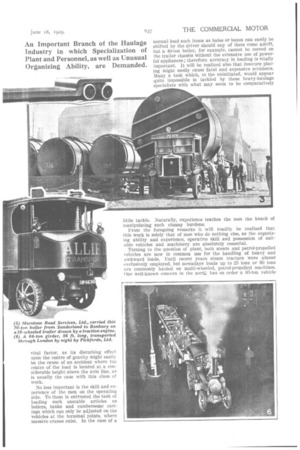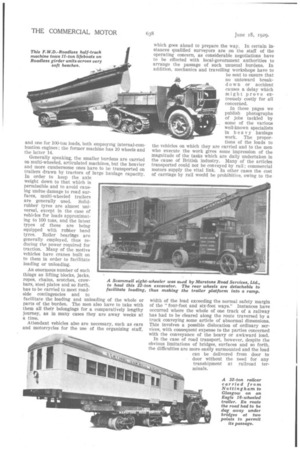THE HANDLING OF AWKWARD LOADS
Page 108

Page 109

Page 110

If you've noticed an error in this article please click here to report it so we can fix it.
LITTLE is known by the man in the street about the transport 1 by road of some of the most cumbrous loads which are occasioned by modern industrial activities. While John Citizen is asleep these burdens, which may reach to so great a total as 100 tons, are being borne upon their way by vehicles in the charge of men to whom the handling of very bulky and weighty pieces of machinery is an everyday task. The reason for public ignorance of this type of work is largely because the machines carrying these imposing loads must usually travel at night when traffic is at a minimum. It would he impossible to transport through the day-time traffic of roads or streets objects which, in many cases, are almost as wide as the highways themselves. It may truly be said that no branch of transport requires more skilled organization than this. For example, the route must be selected so as to avoid bridges which are too low, traffic which is too dense, railway crossings which might be impassable by reason of their width, gradients which could not be surmounted by the vehicles capable of hauling such heavy loads, whilst, what is probably the greatest difficulty of all—i.e., the risk of damage to the roads, adjacent property and the load itself—must always be remembered. The camber of the road is also another
vital factor, as its disturbing effect upon the centre of gravity might easily be the cause of an accident where the centre of the load is located at a considerable height above the axle line, as is usually the case with this class of work.
No less important is the skill and experience of the men on the operating side. To them is entrusted the task of loading such unstable articles as boilers, tanks and cumbersome castings which can only be adjusted on the vehicles at the terminal points, where massive cranes exist. In the case of a
normal load Such items as bales or boxes can easily be shifted by the driver should any of them come adrift, but a 40-ton boiler, for example, cannot be moved on the trailer chassis without the extensive use of powerful appliances; therefore. accuracy in loading is vitally important. It will be realized also that insecure placing might easily cause fatal and expensive accidents. Many a task which, to the uninitiated, would appear quite impossible is tackled by these heavy-haulage specialists with what may seem to be comparatively
little tackle. Naturally, experience teaches the men the knack of manipulating such clumsy burdens.
From the foregoing remarks it will readily be realized that this work is solely that of men who do nothing else, as the organizing ability and experience, operative skill and possession of suitable vehicles and machinery are absolutely essential.
Turning to the question of plant, both steam and petrol-propelled vehicles are now in common use for the handling of heavy and awkward loads. Until recent years steam tractors were almost exclusively employed, but nowadays loads up to 25 tons or 30 tons are commonly hauled on multi-wheeled, petrol-propelled machines. One well-known concern in the norti . has on order a 65-ton vehicle and one for 100-ton loads, both employing internal-combustion engines; the former machine has 10 wheels and the latter 14.
Generally speaking, the smaller burdens are carried on multi-wheeled, articulated machines, but the heavier and more cumbersome ones have to be transported on trailers drawn by tractors of large haulage capacity. In order to keep the axle weight down to that which is permissible and to avoid causing undue damage to road surfaces, multi-wheeled trailers are generally used. Solidrubber tyres are almost universal, except in the case of vehicles for loads approximating to 100 tons, and the latest types of these are being equipped with rubber band tyres. Roller bearings are generally employed, thus reducing the power required for traction. Many of the motive vehicles have cranes built on to them in order to facilitate loading or unloading.
An enormous number of such things as lifting blocks, jacks, ropes, chains, scotches, crowbars, steel plates and so forth, has to be carried to meet roadside contingencies and to facilitate the loading and unloading of the whole or parts of the burden. The men also have to take with them all their belongings for a comparatively lengthy journey, as in many cases they are away weeks at a time.
Attendant vehicles also are necessary, such as cars and motorcycles for the use of the organizing staff, which goes ahead to prepare the way. In certain instances qualified surveyors are on the staff of the operating concern, as considerable negotiations have to be effected with local-government authorities to arrange the passage of such unusual burdens. In addition, mechanics and travelling workshops have to be sent to ensure that no untoward breakdown or accident causes a delay which might prove extremely costly for all concerned.
In these pages we publish photographs of jobs tackled by some of the various well-known specialists In heavy haulage work. The proportions of the loads to the vehicles on which they are carried and to the men who execute the work gives some impression of the magnitude of the tasks which are daily undertaken in the cause of British industry. Many of the articles transported could not be conveyed by rail ; commercial motors supply the vital link. In other cases the cost of carriage by rail would be prohibitive, owing to the width of the load exceeding the normal safety margin of the "four-foot and six-foot ways." Instances have occurred where the whole of one track of a railway has had to be cleared along the route traversed by a truck conveying some article of abnormal dimensions. This involves a possible dislocation of ordinary services, with consequent expense to the parties concerned with the conveyance of the heavy or awkward load.
In the case of road transport, however, despite the obvious limitations of bridges, surfaces and so forth, the difficulties are more easily surmounted and the load can be delivered from door to door without the need for any transhipment at railroad terminals.








































































































































































































